There are many Catholic pilgrimage sites in Lithuania. There is no official list or designation of the sites. The government established the Pilgrim Route of John Paul II (16 sites) in 2007 though there are many more sites that attract local pilgrims. There are many sites visited by residents of the same parish or deanery, or sites that saw their devotion diminish through the years. Priest Robertas Gedvydas Skrinskas in his 1999 guide to pilgrimage sites counted more than 100 Marian images that are considered miraculous and 25 sites of Marian apparitions. [1] As of 2013, there were 33 Lourdes grottoes in Lithuania, mainly in Samogitia. [2] The list below includes only the key sites that continue to be visited by pilgrims.
Catholic pilgrimage sites in Lithuania started developing in the 17th century. Such delayed development was caused by the late Christianization of Lithuania in 1387 and the slow adoption of Christianity among the population that still worshiped pagan gods. [3] The first known pilgrimage took place in 1604 when Bishop Benedykt Woyna organized a Jesuit pilgrimage from Vilnius to the Mother of God of Trakai. Šiluva became a pilgrimage destination after a Marian apparition in 1608—the only recognized apparition in Lithuania. The first cavalries in Žemaičių Kalvarija and Verkiai (Vilnius) were built in 1637–1642 and 1662–1669. [4] Vilnius attracted pilgrims not only with the Calvary, but also with the relics of Saint Casimir in Vilnius Cathedral (dedicated Chapel of Saint Casimir was completed in 1636) and Our Lady of the Gate of Dawn (dedicated chapel was completed in 1671). Many pilgrims traveled not to visit specific sites but to get an indulgence during parish festivals (Lithuanian : atlaidai). [1]
During the Soviet anti-religious campaign in 1958–1964, the authorities of the Lithuanian SSR took active measures to hinder the pilgrims and destroy several pilgrimage sites – chapels of Verkiai and Vepriai Calvaries were demolished while crosses were removed from the Hill of Crosses. [1] After the Lithuania regained independence in 1990, many sites were repaired or reconstructed or new chapels were built (e.g. Janoniai Chapel and Kvintiškės Chapel at the sites of Marian apparitions in 1962 and 1967). In 1993, during his visit to Lithuania, Pope John Paul II visited several key pilgrimage sites, including the Gate of Dawn, Hill of Crosses, and Šiluva. [1] In 2007, for the 15th anniversary of his visit, Lithuanian bishops and Lithuanian government established a pilgrim route of Pope John Paul II with 14 sites; two more sites were added in 2009. The route includes Šiauliai Cathedral and Christ's Resurrection Church, Kaunas due to their architectural and historical significance. [3] In 2013, several Municipalities of Lithuania established several routes inspired by Camino de Santiago (St. James Way) that connect different churches of St. James in different regions of Lithuania. [5]

Vilnius, previously known in English as Vilna, is the capital of and largest city in Lithuania and the second-most-populous city in the Baltic states. The city's estimated July 2024 population was 605,270, and the Vilnius urban area has an estimated population of 708,627.
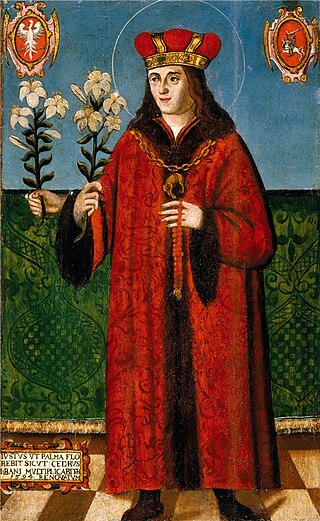
Casimir Jagiellon was a prince of the Kingdom of Poland and of the Grand Duchy of Lithuania. The second son of King Casimir IV Jagiellon, he was tutored by Johannes Longinus, a Polish chronicler and diplomat. After his elder brother Vladislaus was elected as King of Bohemia in 1471, Casimir became the heir apparent. At the age of 13, Casimir participated in the failed military campaign to install him as King of Hungary. He became known for his piety, devotion to God, and generosity towards the sick and poor. He became ill and died at the age of 25. He was buried in Vilnius Cathedral. His canonization was initiated by his brother King Sigismund I the Old in 1514 and the tradition holds that he was canonized in 1521.

Our Lady of the Gate of Dawn is the prominent Christian icon of the Blessed Virgin Mary venerated by the faithful in the Chapel of the Gate of Dawn in Vilnius, Lithuania. The painting was historically displayed above the Vilnius city gate; city gates of the time often contained religious artifacts intended to ward off attacks and bless passing travelers.

Pilėnai was a hill fort in the Grand Duchy of Lithuania. Its location is unknown and is subject to academic debates, but it is well known in the history of Lithuania due to its heroic defense against the Teutonic Order in 1336. Attacked by a large Teutonic force, the fortress, commanded by Duke Margiris, tried in vain to organize a defense against the larger and stronger invader. Losing hope, the defenders decided to burn their property and commit mass suicide to deprive the Order of prisoners and loot. This dramatic episode from the Lithuanian Crusade has caught the public imagination, inspired many works of fiction, and became a symbol of Lithuanian struggles and resistance.
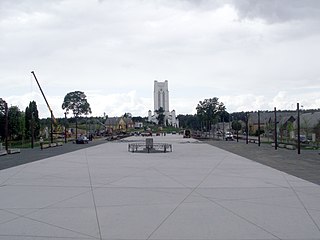
Šiluva is a small town of less than 700 inhabitants in Lithuania. It is located in the region of Samogitia. It is a major site of Catholic pilgrimage in Lithuania.

Hill of Crosses is a site of pilgrimage about 12 km north of the city of Šiauliai, in northern Lithuania. The precise origin of the practice of leaving crosses on the hill is uncertain, but it is believed that the first crosses were placed on the former Jurgaičiai or Domantai hill fort after the 1831 Uprising. Over the generations, not only crosses and crucifixes, but statues of the Virgin Mary, carvings of Lithuanian patriots and thousands of tiny effigies and rosaries have been brought here by Catholic pilgrims. The exact number of crosses is unknown, but estimates put it at about 55,000 in 1990 and 100,000 in 2006. It is a major site of Catholic pilgrimage in Lithuania.

The Catholic Church in Lithuania is part of the worldwide Catholic Church, under the spiritual leadership of the Pope in Rome. Lithuania is the world's northernmost Catholic majority country. Pope Pius XII gave Lithuania the title of "northernmost outpost of Catholicism in Europe" in 1939.

Mečislovas Reinys was a Lithuanian Roman Catholic titular archbishop and professor at Vytautas Magnus University. He was the Lithuanian Minister of Foreign Affairs from September 1925 to April 1926. He was imprisoned by the Soviets in Vladimir Central Prison where he died in 1953. His beatification case was opened in 1998 and he was recognized as a martyr in 2000.
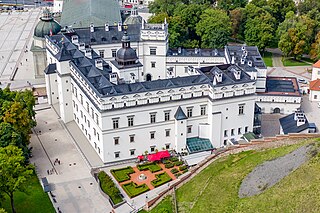
Lithuania attracts many visitors from neighbouring countries and from all over the world. In 2018,there were 1.7 million foreign visitors to Lithuania for business, family and leisure. The historical legacy of the Grand Duchy of Lithuania, its rich history, architecture, pristine nature, seaside and spa resorts are the main attraction points of Lithuania. Domestic tourism is also highly popular: in 2018 it grew by 12%. Lithuanians also prefer to spend their vacations in Lithuania – 70 percent.

The first known record of the name of Lithuania recorded in the Quedlinburg Chronicle in a 9 March 1009 story of Saint Bruno. The Chronicle recorded in the form Litua. Although it is clear the name originated from a Baltic language, scholars still debate the meaning of the word.
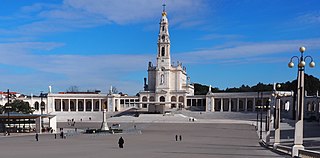
The Sanctuary of Fátima, officially titled Sanctuary of Our Lady of the Rosary of Fátima, is a Marian shrine dedicated to Our Lady of Fatima located in Fátima, in the municipality of Ourém, in Portugal. It consists of a group of Catholic religious buildings and structures with the Basilica of Our Lady of the Rosary as the main building.
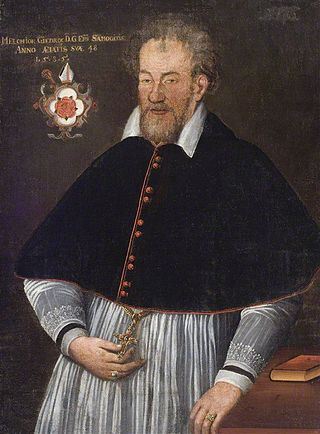
Merkelis Giedraitis was Bishop of Samogitia from 1576 to 1609. Educated at Protestant universities in the Duchy of Prussia and Germany, he actively combated the Reformation implementing resolutions of the Council of Trent in Samogitia. Born into the princely Giedraičiai family, he inherited a much neglected diocese that was reduced to only about 20 priests. He became known for his devotion and work to end clerical abuses, strengthen churches and schools, and increase the number of priests. Giedraitis invited the Jesuits to Kražiai where the Kražiai College was established already after his death and the Bernadines to Kretinga where they established the first monastery in Samogitia. He sponsored Mikalojus Daukša, who translated and published Catechism (1595) and Postil (1599) in the Lithuanian language—the first Lithuanian books printed within the Grand Duchy of Lithuania. He also supported Maciej Stryjkowski, author of the first printed history of Lithuania. In recognition of his efforts, Giedraitis is often referred to as the second baptist of Samogitia.
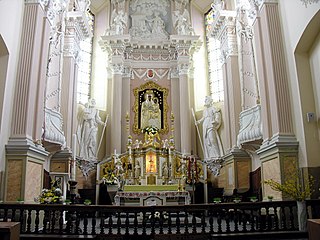
Our Lady of Šiluva is Roman Catholic image of the Blessed Virgin Mary venerated at the Basilica of the Nativity of the Blessed Virgin Mary, Šiluva shrine in Lithuania. The patriotic icon is highly venerated in Lithuania and is often called Lithuania's greatest treasure.

A parish festival or parish fair or indulgence feast is a local annual festival held by Roman Catholic churches in Poland and Lithuania on a feast day of the patron saint of a given parish. Many of the festivals have long historic traditions that date back to the Counter-Reformation in the 16–17th centuries. Almost every parish has such festival with some churches having several. Participants in these festivals can receive indulgences for themselves and their dead relatives. The festivals include masses, religious processions, performances by church choirs, other music performances and are often accompanied by traditional craft markets. The feasts reinforce local identity and foster a sense of community. Some of the larger festivals, like the Great Žemaičių Kalvarija Festival, last for a week, attract thousands of people, and are major pilgrimage events.

The Society of Saint Casimir was a Lithuanian society that published Lithuanian-language books and periodicals, many on Roman Catholic church and faith. Established in 1905, right after the Lithuanian press ban was lifted, the society published a total of about 740 books and several periodicals, including the first full Roman Catholic Bible translation into Lithuanian in six volumes in 1911–1937. From 1918 it operated its own printing press Šviesa. The society was liquidated after Lithuania was occupied by the Soviet Union in June 1940.
The First Congress of Lithuanian Women took place on 6–7 October [O.S. 23–24 September] 1907 in Kaunas. It was organized by Catholic priests in preparation for the October 1907 election to the third State Duma but discussed only cultural and economic issues. The organizers attempted to invite representatives of different social classes and political affiliations leading to disagreements between socialists and Catholic clergy, and between educated intellectuals and less educated villagers. The congress resolved to establish the Lithuanian Women's Union. However, disagreements between the liberals and the Catholics led to splintering of the women's movement and to the establishment of the Association of Lithuanian Catholic Women in January 1908. The Women's Union was officially established only in 1922.
Ramybė Park is a public park in Kaunas, Lithuania, established in 1959 in the territory of the Kaunas City Old Cemetery that was also known as the Carmelite Cemetery. The cemetery was established in 1847 and became the main city cemetery with sections for four different religions – Roman Catholics, Eastern Orthodoxs, Lutherans, and Muslims. During World War I and subsequent Lithuanian Wars of Independence, Russian, German, and Lithuanian soldiers were buried in the cemetery. During the interwar period when Kaunas was the temporary capital of Lithuania, many famous people were buried there and several buildings were constructed on the cemetery's territory. In 1930, a monument to fallen Lithuanian soldiers with a tomb of an unknown soldier was unveiled. Around the same time, a tradition to honor fallen soldiers on the All Saints' Day began.

Eustachy Wołłowicz was Bishop of Vilnius in 1616–1630. He was one of the more accomplished bishops of Vilnius in the 17th century.
Vincentas Taškūnas (1880–1967) was a Lithuanian Roman Catholic priest.